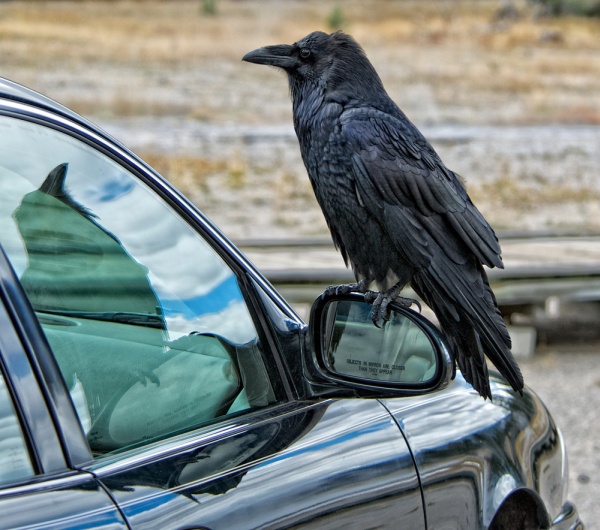
… are closer than they appear!
The message on the passenger side mirror takes on a whole new meaning.
.
(photo by David Kay via Shutterstock.com)

… are closer than they appear!
The message on the passenger side mirror takes on a whole new meaning.
.
(photo by David Kay via Shutterstock.com)
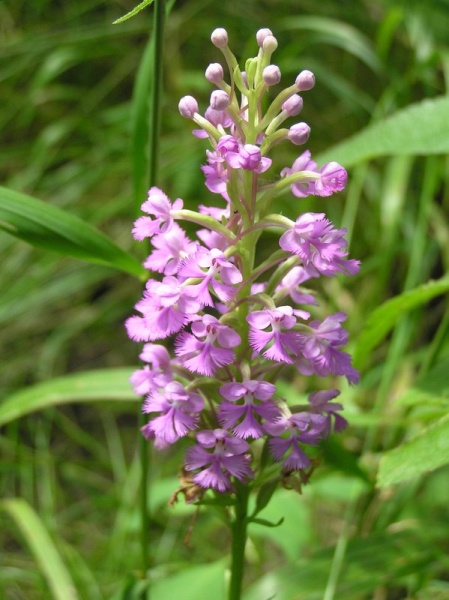
The Lesser or Small flowered purple fringed orchid (Platanthera psycodes) is blooming now in western Pennsylvania. Its flowers are small — only 1/2″ across — but they make up for their size by clustering 30 to 50 on the stem.
You’ll find this orchid in wet spots in the woods, in damp meadows, and along streams and seeps.
Dianne Machesney photographed this one during a Wissahickon Nature Club outing last Tuesday. The outing honored Esther Allen who certainly would have enjoyed seeing this plant.
(photo by Dianne Machesney)

29 July 2011
Monday morning a storm was brewing when I looked out the window and saw a roofer walking on Central Catholic’s steep slate roof. He and his crew had come to replace a few bad slates.
I have a healthy fear of heights and lightning so I was morbidly fascinated. Would they be macho about the approaching storm or would they leave?
Two of them were up there when a brief downpour swept by. The roof became slippery. They sat down.
The next time I looked the crew was off the main roof waiting on a lower level while the boss walked the ridgepole. He examined the approaching black cloud with professional interest. There was lightning in it. He pointed out the cloud’s leading edge to the crew as it slowly moved south. Would he get off that roof?!?!
I know enough about lightning that I didn’t want to see what might happen. I stopped watching.
In most years lightning kills more people than tornadoes and hurricanes combined. (This year’s Joplin tornado turned that statistic on its head.) Most people survive lightning strikes but have lifelong health problems afterward. Most people are hit by lightning when it’s not raining — probably because they don’t take shelter unless it rains.
I avoid lightning and have learned that…
A friend once told me a harrowing story of being in a rustic cabin in Canada during a nighttime thunderstorm. Lightning repeatedly hit the ground and came up through the floor. It made the bedsprings glow. Yikes!
My worst scare was the time I parked at the top of Laurel Mountain and hiked down the Tebolt Trail at Quebec Run Wild Area. Thunderstorms were predicted to arrive at 2:00pm but I lost track of time. At 1:00pm I heard thunder and knew it would take at least an hour to walk back up the mountain no matter how fast I went. I started to walk and run uphill. By the time I reached the top of the mountain the storm was quite close and I was praying and bargaining, “Not now! Please wait!” I made it to the car, slammed the door and “BOOM!” The lightning didn’t hit me but my heart sure beat fast!
I could never be a roofer.
And, yes, the roofers left before the storm.
p.s. Do you have any close calls with lightning? As I said, I’m morbidly fascinated.
(photo by “jcpjr” from Shutterstock.com)
Last week when I wrote about the Avian Architecture book, Sharon Leadbitter commented on two amazing nests she’d seen on the web. Here’s one of them.
Sociable weavers (Philetairus socius) are sparrow-sized birds who live in the Kalahari desert in Namibia, Botswana and South Africa.
Unlike most birds who build a nest for their own babies and then abandon it when the young have flown, sociable weavers build a permanent structure that functions as a communal nest and roost. It’s the size of a small car, the largest nest found anywhere, and can house up to 100 pairs of birds, their children and grandchildren.
The top of the nest is basically flat while the underside, shown above, is dotted with entries to the chambers. The weavers build it entirely of straws which they shove into the structure. This BBC video by David Attenborough shows how the weavers do it.
Sociable weavers are such good builders that other species, such as the pygmy falcon, nest in the empty chambers while the weavers live there.
It’s an amazing feat for a small bird. They’ve built a city in a tree.
(photo BBC Worldwide video posted on YouTube.com)

I was doing the laundry the other day when I picked up a jug of detergent from the basement floor and this critter dropped off the underside onto our gleaming white washing machine.
He was not happy to be exposed in a high, bright place so he ran to the edge of the machine and looked down.
I was startled (I think I screamed) but I got a good look at him before I killed him. (Did I tell you I hate bugs?) His long flat body and curved pincers impressed me so much that I looked him up.
This is a male earwig!
Despite the name, earwigs do not crawl into human ears. They’re nocturnal insects who spend the day hiding in dark damp crevices and come out at night to eat living and dead plants and animals, including insects. I should probably be grateful to have a few patrolling my basement.
Earwigs are really successful bugs. They first appeared in the late Triassic period 208 million years ago and they are still around today. For comparison Dippy the Dinosaur (Diplodocus carnegii) lived for about 5 million years in the late Jurassic period, 154-150 million years ago.
Part of earwigs’ success may be due to this unusual trait: Though they are not social insects, the mother earwig guards her eggs and babies. She continuously cleans the eggs to remove fungi, monitors their warmth and protects them from predators. When the eggs hatch she stays with her young until their second molt.
There are 1,800 species of earwigs on earth but they don’t survive winter outdoors so there are only 25 species in North America. The European earwig (Forficula auricularia) was introduced from Europe in 1907, the same year my house was built.
After all this time I finally noticed my house is home to this prehistoric bug.
(photo by Scott Hussey via Shutterstock.com)
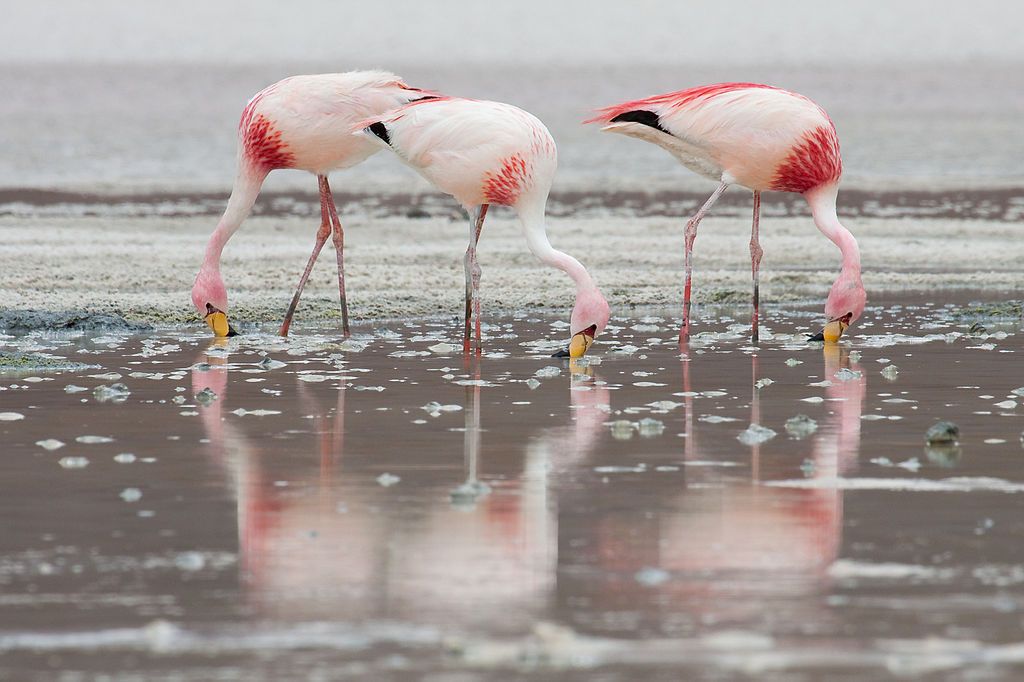
These rare James’s flamingos live in the Andes mountains of South America.
Though only three feet tall, their colors are stunning with pale pink bodies, yellow beaks, black wingtips, and bright carmine accents on their necks and backs. They look as if they were painted.
Until I found this photograph on Wikimedia Commons, I had no idea these birds existed. They’re so beautiful I had to share them.
“The world is so full of a number of things,
I’m sure we should all be as happy as kings.”— Robert Louis Stevenson
(photo by Christian Mehlführer on Wikimedia Commons. Click on the caption to see the original)
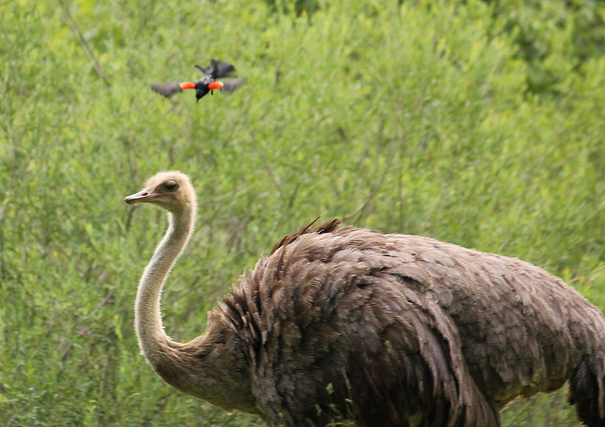
25 July 2011
When Steve Valasek’s family visited the Pittsburgh Zoo last month they saw an amazing episode at the African Savannah exhibit.
Steve writes, “A male Red-Winged Blackbird was attacking an Ostrich in the enclosure. The bird would land on the Ostrich’s back and peck or pull its feathers. There was a female Blackbird around too, so I’m assuming that there was a nest nearby.”
That blackbird is angry! Look at his red shoulders as he attacks the ostrich.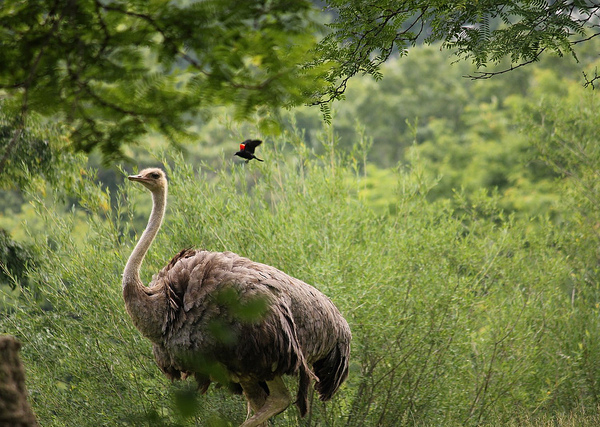
The ostrich takes a few steps. The blackbird attacks from behind…
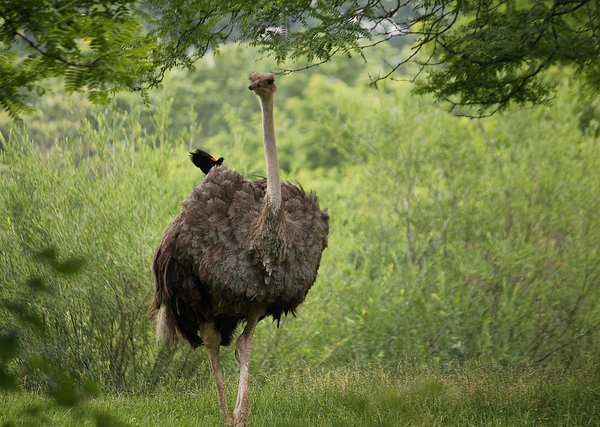
…then circles back for another attack.
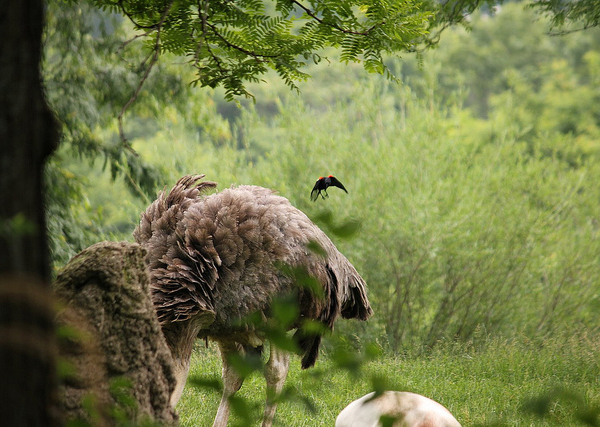
Victory! The blackbird lands on the ostrich while his mate watches from above.
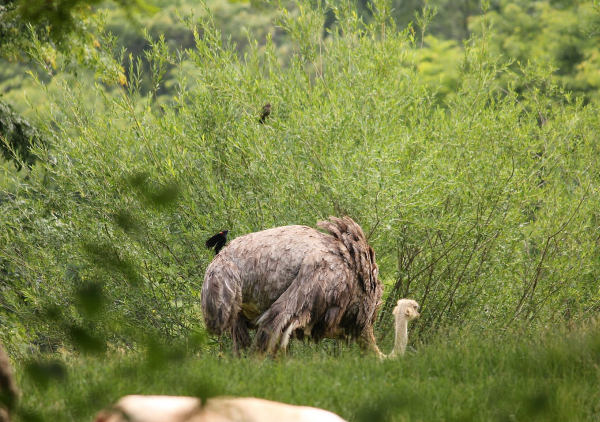
“I don’t care how big you are!” says the blackbird, “Get out of here!”
Finally the ostrich moved away.
The blackbird won the battle but not the war. The ostrich isn’t going to leave the enclosure.
For Steve’s entire photo sequence, click here.
(photos by Steve Valasek)

The weather has moderated a little, but it’s still hot and humid.
I’d like to go hiking but southwestern Pennsylvania has a 50% chance of thunderstorms today and I won’t go out there in lightning if I can avoid it.
Now it looks unavoidable. The sky has become ominously dark as I write.
If the weather was merely hot I’d visit Cucumber Falls, pictured above. The falls are part of Cucumber Run in Ohiopyle State Park and they’re easy to get to. There’s a parking lot near the falls for a quick visit, or you can get a better look at Cucumber Run by hiking the Great Gorge Trail. Hike upstream to feel the cool air in the creek valley or walk downstream to the Youghiogheny River where you can watch the rapids. Here’s a map of the park. (The map takes a while to download. If it looks black, change the zoom and the map will appear.)
Unfortunately Ohiopyle is a 90 minute drive from Pittsburgh and I can’t see driving that far to wait in the car for a storm to pass.
I guess I’ll have to stay close to home and merely think cool thoughts.
(photo of Cucumber Falls by Caleb Foster from Shutterstock.com)
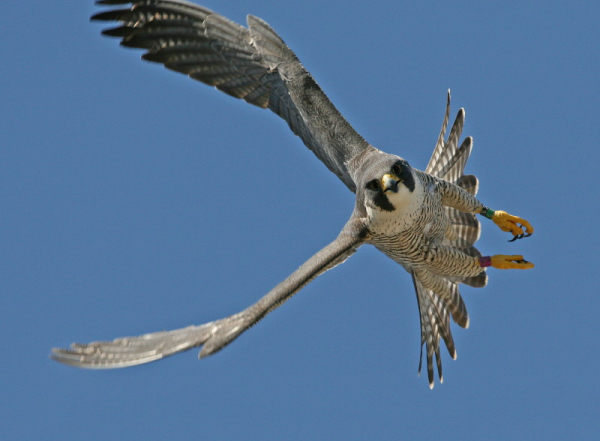
This beautiful bird, the grand peregrine queen of Youngstown, Ohio, died this week.
Stellar had nested in Youngstown since 2005 with her mate Stammy, who was born at the Cathedral of Learning in 2003. In human terms this made Stellar Dorothy’s daughter-in-law.
In the early years Stellar and Stammy nested in a cornice hole in the old Stambaugh Building, then in a nestbox at Stambaugh. Unfortunately the building’s owner had the nestbox removed so the peregrines had to find a new site in 2009. That year they had success at the Mahoning County Courthouse.
This year a nestbox was provided at the International Towers building. Stellar laid eggs there but the nest failed so she went back to the Courthouse and laid another clutch. She hatched three chicks — named Magistrate, Jurist and Marshall (Ohio names their peregrines) — and all three fledged.
On Friday July 15 Karen Lang visited Youngstown and saw the entire family of five. Days later two of the peregrines went missing: Jurist and Stellar. Sadly, Jurist landed on the ground and was killed by a car.
Stellar was found in a parking area under the Market Street bridge on July 18, very thin with an injured leg. It appeared that she hadn’t eaten for days. Though Birds in Flight Sanctuary tried to save her she died that night. (Read more here.)
Stammy is now alone with two dependent youngsters. He’s a good dad with years of experience so I’m sure he’ll successfully raise them to independence.
I’m also sure a new female peregrine will arrive on the scene to become Stammy’s mate. She’ll have some big shoes — er rather, wingspan — to fill.
(photo of Stellar in flight by Chad+Chris Saladin)
p.s. I’ve featured Stellar in the past at It Takes Two and Concentrate!
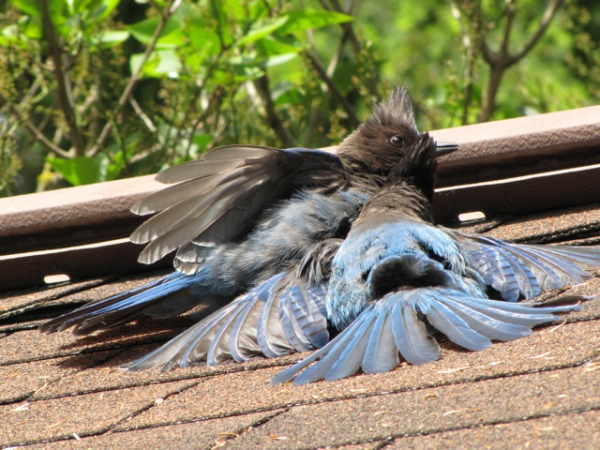
It looks like these Steller’s jays are overcome by the heat but they’re actually sunbathing on Michelline Halliday’s roof in Seattle.
Today is the wrong day to sunbathe in Pittsburgh! The high will be 94oF but the heat index will make it feel like 102o. Last night at 9:00pm it was still 89o with a heat index of 97o. This morning it was 80oF at dawn. And did I mention that the air will be bad? Stay indoors.
Today it will be only 69oF in Seattle. (I’m so jealous!)
Even so, it looks like one jay is saying to the other, “Hot enough for you?”
(photo by Michelline Halliday)